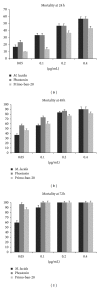Insecticidal activity and chemical composition of the Morinda lucida essential oil against pulse beetle Callosobruchus maculatus
- PMID: 25143991
- PMCID: PMC4131103
- DOI: 10.1155/2014/784613
Insecticidal activity and chemical composition of the Morinda lucida essential oil against pulse beetle Callosobruchus maculatus
Abstract
Insecticidal activity of essential oil extracted from Morinda lucida was tested on pulse beetle Callosobruchus maculatus, which is a pest that causes serious damage to several pulses. The insecticidal activity was compared with two pesticides, Phostoxin and Primo-ban-20. 120 mixed sex adult C. maculatus were introduced, along with 30 g of cowpeas. Four concentrations (0.40, 0.20, 0.10, and 0.05 μg/mL) of the M. lucida essential oil, Phostoxin, and Primo-ban-20 were tested. Essential oil chemical composition was analyzed by GC-MS. M. lucida essential oil showed a high toxicological effect, producing 100% mortality after 72 hours at a dose of 0.20 μg/mL. M. lucida essential oil had a potent insecticidal activity (LC90 = 0.629 μg/mL) compared to both pesticides, Phostoxin (LC90 = 0.652 μg/mL) and Primo-ban-20 (LC90 = 0.726 μg/mL), at 24 h. The main compounds of the essential oil were the oxygenated monoterpenoids, 1,8-cineole (43.4%), and α-terpinyl acetate (14.5%), and the monoterpene hydrocarbons, mostly sabinene (8.2%) and β-pinene (4.0%). Results clearly indicate that M. lucida essential oil can be used as an effective alternative for pulse beetle C. maculatus control, and it could be tested against other pulse beetles affecting Asia and Africa and throughout the world, thereby reducing use of synthetic pesticides.
Figures
References
-
- Park C, Kim SI, Ahn YJ. Insecticidal activity of asarones identified in Acorus gramineus rhizome against three coleopteran stored-product insects. Journal of Stored Products Research. 2003;39(3):333–342.
-
- Mulatu B, Gebrmedhin T. Oviposition-deterrent and toxic effects of various botanicals on the Adzuki bean beetle, Callosobruchus chinensis L. International Journal of Tropical Insect Science. 2000;20:33–38.
-
- Ajayi FA, Lale NES. Seed coat texture, host species and time of application affect the efficacy of essential oils applied for the control of Callosobruchus maculatus (F.) (Coleoptera: Bruchidae) in stored pulses. International Journal of Pest Management. 2001;47(3):161–166.
-
- Tapondjou LA, Adler C, Bouda H, Fontem DA. Efficacy of powder and essential oil from Chenopodium ambrosioides leaves as post-harvest grain protectants against six-stored product beetles. Journal of Stored Products Research. 2002;38(4):395–402.
MeSH terms
Substances
LinkOut - more resources
Full Text Sources
Other Literature Sources
Miscellaneous


